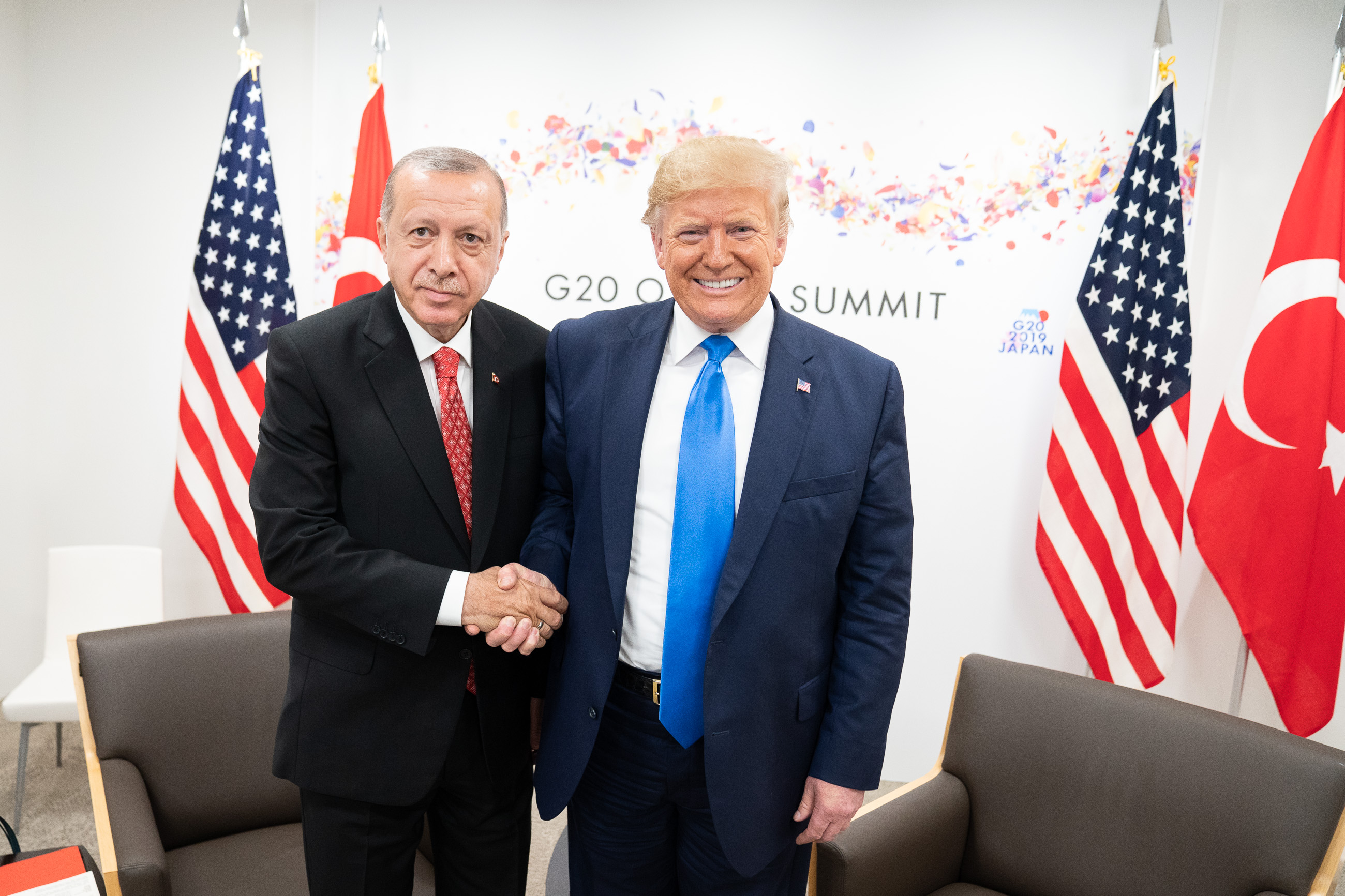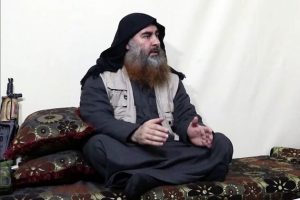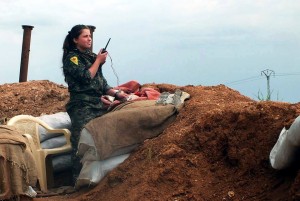by Derek Davison
Since Donald Trump announced last month that he was pulling U.S. forces off of the border between Syria and Turkey, U.S. policy in northeastern Syria has become almost inscrutable. Trump’s announcement green lit a conflict between Turkey and the predominantly Kurdish Syrian Democratic Forces (SDF), who had served as U.S. proxies in the conflict against the Islamic State (IS or ISIS). Trump then dispatched representatives to Turkey to negotiate an abrupt ceasefire to the conflict he’d started. Now it appears that the U.S. will not withdraw from northeastern Syria, but is in fact deploying new forces to “secure” eastern Syrian oil fields, to unknown aims. To get some perspective on what has been a rapidly developing situation, LobeLog spoke with Joshua Landis, director of the Center for Middle East Studies at the University of Oklahoma and expert on Syria.
Q) Last December, after a phone conversation with Turkish President Recep Tayyip Erdogan, Donald Trump abruptly announced that he would withdraw U.S. forces from northeastern Syria. After a frenzied few weeks, Trump partially reversed course and decided to reduce the number of US forces in that region by half. Earlier this month, after another phone conversation with Erdogan, Trump abruptly announced again that he was withdrawing U.S. forces from the Syria-Turkey border region. Over a frenzied couple of weeks, that became a full withdrawal from northeastern Syria altogether, then a partial withdrawal. Now Trump has decided to leave roughly the same number of soldiers in the area as before, but with heavy armor—meaning he’s arguably increased the U.S. military presence when he set out to reduce it. This all seems chaotic, to say the least. Can you find a consistent throughline or has it just been one impulsive decision after another?
A) In many ways, our foreign policy in the Middle East has become dissociated from the broader national interest and certainly from public opinion. This is a problem for any elected official, because we’ve spent—as Trump continually reminds us—six or seven trillion dollars in the Middle East for nothing, or what seems to be nothing to the American public. Politicians can’t really explain what that money has bought us. With a foreign policy establishment that has become very anti-Iran and very pro-Israel, and is willing to spend trillions of dollars to pursue these policies, the American people feel like they’ve been abandoned by Washington. It’s one of the aspects to a broader sense that there’s deep corruption in the political system and that our political elites are acting in their own inscrutable interests.
So when Trump said [during the 2016 campaign] that we’d wasted our money and that he was going to end these “stupid wars,” that was wildly popular. Even his most fire-breathing Republican competitors had to change their foreign policy approaches. It was extraordinary to watch. Trump discovered the sweet spot of the American public. This is the broader context—Trump is gearing up for his reelection campaign. He started last December, after the midterm elections. During the midterms, Republican candidates wanted to appear very anti-Iran and pro-Israel on Middle East policy, and Washington interests spent a lot of money to make sure they adhered to that line.
But as soon as the midterms were over, Trump came out and began to talk, again, about ending “stupid wars.” That’s when he wanted to pull out of Syria, and he thought it would go over well and be a calling card. He also proceeded with talks to pull out of Afghanistan, but those ended up in the train wreck we saw in September, and so he’s probably not going to be able to pull out of Afghanistan by the election. This approach meant that he would be at daggers drawn with his chief foreign policy advisers, who were all anti-Iran hawks—[former National Security Advisor] John Bolton, [Secretary of State] Mike Pompeo, and you can go right down the line. So Trump fired Bolton and decided to change course rather than be sucked into a war with Iran. Then he talked with Erdogan, and now we’ve got the chaos we’re currently seeing, which is the result of a president who is out of sync with his foreign policy principals.
Erdogan, of course, is smart. He understood, beginning in December, that he was dealing with people who were focused initially on fighting ISIS and then fell increasingly in love with the Syrian Kurds. So he moved toward Russia, in order to get Washington’s attention and hedge his bets, and he began threatening to invade northeastern Syria, to create an emergency situation and force the CIA, State Department, and so forth to escalate the situation to the president. Trump looked at the situation and decided that there was nothing to gain from a conflict with Turkey—and he clearly likes Erdogan on some level.
Erdogan understood from the December experience that Trump was very favorable to his interests, and he subsequently refused to deal with anyone in the administration apart from Trump himself. The Trump administration kept trying to delay him with talk of a safe zone, joint patrols, and so on, but Erdogan went back to his previous approach of escalating the situation with repeated talk of an invasion until, earlier this month, he’d gotten the issue back before Trump again. And Trump reiterated what everybody already knew he believed, which is that he wanted to get out of Syria. The underlines the irresponsibility of his foreign policy principals, who clearly see Trump as stupid and believed they could play him to get him to change his basic understanding.
Q) The experience of that December pronouncement and subsequent reversal probably should have made it clear that Trump wanted to get out of Syria, but instead it seems to have taught his advisers that they could cajole Trump into doing what they wanted. In your opinion, was there a failure within the administration to anticipate that Trump would return to his desire to withdraw and perhaps develop an approach that would allow the U.S. to withdraw without creating so much chaos and without leaving the SDF in the lurch?
A) [Former Special Presidential Envoy for the Global Coalition to Counter ISIL] Brett McGurk is now claiming that he advised senior leaders of the YPG [the Kurdish militia that makes up the bulk of the SDF] to make a deal with the Syrian government. The trouble is that he quit after Trump’s announcement in December and was replaced by James Jeffrey, a strident Iran hawk who immediately told the Kurds not to make a deal with Damascus. So all the vectors of the administration’s Syria policy went back to the anti-Iran agenda, where the long-term goal was to interfere with Iran’s regional activities and the plan was that the U.S. would not leave Syria until Iran was driven out—which means never, because Iran is not going to be driven out of Syria as long as Bashar al-Assad is in charge.
To most Syria watchers, nothing that Jeffrey said struck one as being honest, true or possible. He said the US would get rid of Assad through its leverage in northern Syria, that it would get a credible constitutional process underway leading to real elections overseen by the United Nations. Nobody really believes that. Assad has won. Jeffrey kept on insisting that Assad has lost, because the U.S. had all of his wealth locked up in the northeast of the country, which is not true. Assad is surviving, has Russia and Iran supporting him, and has confined the rebels to Idlib under the control of extremist jihadists who have little popular support. Nothing that came out of Jeffrey’s office made any sense to anybody who knows anything about the region, and it didn’t make any sense to Erdogan.
When the U.S. switched from the Free Syrian Army to the Kurdish YPG as its main instrument for influencing Syria in 2015, it squared that decision with Turkey by telling Erdogan it would only be a temporary alliance to deal with ISIS. Erdogan was apoplectic, but the U.S. assuaged him by promising to take back its heavy weapons from the YPG and to leave Syria once ISIS was defeated. America was lying to him, and he understood that they were probably lying to him, but needed to play it out because he knew he would be accused of allying with ISIS if he didn’t go along. As soon as ISIS was destroyed he wanted the U.S. out of there, and tried to make it clear to the Americans that they would not be able to occupy northeastern Syria forever and potentially create an independent Kurdish state there. But the Trump administration—James Jeffrey and others—believed that they could stay there forever. Erdogan’s escalation forced the U.S. to choose between Turkey and the Kurds, believing that if push came to shove the U.S. would choose Turkey. Which it did.
Q) The administration’s new plan is to withdraw some U.S. forces from northeastern Syria but replace them with other U.S. forces, including armor, to “secure” eastern Syria’s oilfields. This seems transparently like something the Pentagon cooked up to appeal to Trump’s baser instincts and convince him to reverse course on the withdrawal. But Trump has talked about actually extracting Syrian oil, distributing it to the Kurds, and even keeping some for the U.S. Under international law this is obviously pillaging, which is a war crime. Is there anything to his talk about taking Syrian oil or is it still just cover for reversing the withdrawal?
A) This is exactly as you described it—a “Hail Mary” maneuver by people in the Pentagon, and in the State Department (Jeffrey, et al), who want to stay in Syria and saw this as a last gasp effort to get the president to walk back from his withdrawal. They remembered Trump’s campaign rhetoric about the Iraq War, when he talked repeatedly about how if he had been president the U.S. would have taken the oil. Trump clearly liked the idea and thought he could sell it to the American people. This just shows you how dysfunctional our foreign policy has become, where you have these little factions fighting over things and coming up with policy that makes zero sense for U.S. interests.
It’s not going to really happen. Why? Because first of all it’s illegal, and people are already pointing that out. Secondly, ExxonMobil is not going to go in and rehabilitate these oil fields and get the oil out, as the president said they would. These fields have been so damaged, not only by bombing but by people who don’t know what they’re doing, that it would cost hundreds of millions, if not billions, of dollars to rehabilitate them, and nobody’s going to do that because they don’t believe the U.S. is going to be there that long. No self-respecting oil company is going to be involved in a policy they believe is cockamamie, and illegal.
What you could do is draw off the dribs and drabs that are still coming out of these wells without any rehabilitation, and truck them out. Which is what’s happening now. But whose oil is it? Is America just going to give it to the CIA and the Defense Department and let them run operations in the region using Syria’s oil? I don’t think so. They might try to do that, but then everybody is going to point out that it’s totally illegal. Even the Kurds will dislike it, because they’ll want their share. But the Kurds can no longer deal with the U.S. on their own, because they’ve had to seek protection from Assad, and Assad can threaten to abandon them to the Turks if they cooperate with the U.S. in a plan to plunder Syria’s oil.
Who are going to be the proxies guarding these oil fields? It will have to be U.S. troops, and they’re going to be sitting ducks. It puts America in a position it didn’t want to be in, with U.S. soldiers vulnerable to attack, surrounded by hostile forces looking to drive them out of the region, and without a legal justification for being there. I think that as cooler heads try to grapple with this policy it will become clear that it’s temporary and won’t even produce enough money to pay for itself, and that it’s a drag on the U.S. position in the region because it’s not supported by any local or regional actors. It’s a sad commentary on the level of dysfunction in U.S. foreign policy. We’ve never seen it at this level before, and we need to hope a different administration comes in and sorts it out.
Q) What is the current disposition of forces in northeastern Syria? The SDF has made a deal with Russia and the Syrian government to bring their forces to the border. Russia and Turkey are now conducting joint patrols of the area. Russia claims that SDF fighters have withdrawn from the border but Turkey says they have not. The Turkish army and Syrian army have skirmished around Ras al-Ayn. There are now even reports of the U.S. patrolling the border again, possibly alongside the SDF. Will things find an equilibrium and what’s likely to be the major concern moving forward?
A) Turkey is clearly pushing and pulling to see how much territory it can take. Russia and Syria are trying to contain it, and Russia is trying to mollify Turkey with these joint patrols, just as the U.S. did. Turkey’s ostensible reason for being on the border is national security, to roll back the YPG. But there’s another reason Turkey is there, which is revanchism—making Turkey great again. Erdogan is constantly speaking to his people in terms of the glories of the Ottoman Empire and arguing that this is a turning point in history. This suggests that he sees the current national borders in the region as in flux, and that a bold and courageous leader—as he sees himself—can take land, to make up for what he sees as the bad deals Turkey accepted at the end of World War I.
So we don’t really know what Erdogan’s game plan is, and I don’t think he fully knows either. He’s pushing as hard as he can at the border to see how much he can get away with. How strong is the Syrian army? How capable are the Kurds? How much will the Kurds cooperate with the Syrian army or are they unable to cooperate? Can we divide and conquer? This confusion at the border, opened up by the sudden withdrawal of the United States, is a hunting ground for all sides, who are trying to see what they can manage.
Russia, Iran, and Syria are adamant in insisting on Syria’s sovereignty and international law. They want to go back to the Adana Agreement of 1998, which was negotiated when Turkey was accusing Damascus of harboring Kurdistan Workers’ Party (PKK) leader Abdullah Ocalan and had threatened to invade Syria. They agreed that the Turkish army could cross the border in pursuit of PKK fighters up to six kilometers into Syria, but they had to coordinate with the Syrian army and withdraw immediately after. The Syrian government was to be in charge of policing the PKK and controlling the border.
Q) One of the main components of the Turkish operation has been the “Syrian National Army” (SNA), which is effectively the rebranded “Free Syrian Army.” The SNA includes extremist factions who have made it clear they still support Assad’s ouster. Can the Turks keep these fighters in check, and do they even want to keep them in check?
A) The SNA is the repackaged Free Syrian Army, leavened with Islamists and filled with people who have been fighting for nine years and are very hardened. They are highly anti-Assad and also see the Kurdish YPG as intimately connected with the Assad regime and the U.S., who they all view as co-conspirators.
Assad runs a “minority strategy” in Syria. He’s got an increasingly strong alliance with more secular liberal Sunnis, many of whom have come to realize that he’s going to win and they have to make peace with that. But his minority strategy, which has been the core of his strategy since the beginning of the Syrian uprising, has been to ally with all of Syria’s minorities against Sunni Islamists—who are the muscle of the uprising. And so he needs the Kurds, who are a minority and have looked to Damascus to protect them. That’s why Hafez al-Assad sheltered Ocalan in the 1970s and helped build up what would become the YPG, to use as a cat’s paw against Turkey.
When Bashar al-Assad withdrew from northeastern Syria in 2012 because he needed to concentrate his forces in the west, he left it to the YPG, because the YPG and Assad have common enemies in Turkey and in the Sunni Islamist rebels. They seek to drive the Kurds out of the Euphrates valley and ethnically cleanse the region, as they’ve already done in Afrin—replacing the region’s Kurdish population with SNA fighters and returning Syrian Arab refugees who will be totally dependent on Turkey. Assad and the Kurds have been driven together by this common enemy, and Assad is now following the same plan the U.S. followed—using the Kurds as proxies to fight Islamist rebels and control northeastern Syria.
Q) Do the Kurds have any leverage anymore to extract concessions from Damascus in return for their military support? Has their goal of an autonomous Kurdish region now become unachievable?
A) The Kurds do have leverage, but they’re not going to get political autonomy or military autonomy, which is what they wanted and what the U.S. was offering. The Kurds number fewer than 2 million people in Syria, their region is poor and tremendously underdeveloped, and most importantly they don’t have an air force. The moment the U.S. withdraws they’re sitting ducks. Their leverage is that the other population in northeastern Syria, the Arab tribal population, is extremely anti-Damascus. This is the population that went into revolt, then came under the control first of al-Qaeda’s Nusra Front and then ISIS. Many of the tribes have been cooperating with ISIS. The Kurds know how to fight these people. They have intelligence and U.S. training, and Assad needs them to keep doing what they’ve been doing, so he’s going to want to use them the way the U.S. did.
Assad is terrified of the “Iraq model.” He does not want northeastern Syria to become quasi-independent the way northern Iraq is. On a cultural level, the Kurds can have a great deal of autonomy. But Assad has insisted that they can’t have military or political autonomy.
Q) Where does the conflict in Syria go from here? Will Damascus now resume its offensive against the rebels in Idlib province or will it focus first on stabilizing the northeast? Will Turkey and Syria eventually come to blows over the pieces of Syria the Turks now control?
A) For the next few months it’s going to be about stabilization in the northeast. The vacuum left by the U.S. withdrawal has created a scramble among Turkey, Syria, and the Kurds, and until that gets sorted out everybody’s efforts will be focused on that. But Idlib will be the next giant flashpoint, because it is a cauldron of trouble. We just saw Abu Bakr al-Baghdadi hunted down there, but he’s just the tip of the iceberg. There are a plethora of Islamist groups in Idlib that have delusions of grandeur. Hayat Tahrir al-Sham and Abu Mohammad al-Julani—he believes that he should be ruling Syria. Then there’s Hurras al-Din, which is the “official” al-Qaeda affiliate in the area, and there are other militias—Circassians, Chechens, Uyghurs—all of whom have no place to turn but who all look to Turkey and the West to protect them to some degree.
In terms of the propaganda war, Western governments will focus on the families of the jihadists who live in Idlib and the potential humanitarian consequences of a conflict there. The Syrian government will focus on the alternative narrative, which is that Turkey and Julani gave protection to Baghdadi, that Idlib is “the largest al-Qaeda safe haven since 9/11,” as McGurk once put it, and that Syria can’t go on indefinitely with this pocket of territory under rebel control. Russia will support the Syrians, and the West is going to have to figure out where they stand on that.






Oh! Yes U.S. is retreating but not retreating from Syria… the oil fields, how come!